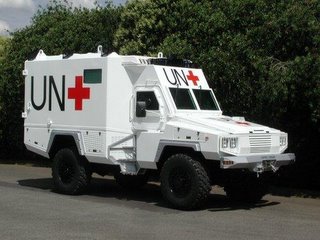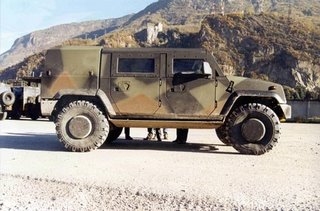In a posting
at the end of June we drew attention to an extraordinary deception perpetrated by the Ministry of Defence, in relation to the procurement of a new type of armoured vehicle for the British Army, then known as the Multirole Light Vehicle (MLV).
With its announcement in July 2003 of the "preferred bidder" – and subsequently – the MoD sought to give the impression that the vehicle was British-made. It was only through persistent questioning from Conservative back-bench MP Anne Winterton that it emerged that the vehicle was not only entirely Italian-designed but was also to be manufactured (all bar the roof) by the Italian firm Iveco in Italy.
Not least of our concerns was the extraordinary price of each vehicle, at £413,000 – twice the price of a Rolls Royce limousine – but what particularly aroused our suspicions were the lengths to which the MoD had gone to conceal the European origin of the vehicle. After the award of the contract to supply trucks for the British Army to the German firm
MAN-Nutzfahrzeuge, this we felt might be more evidence of what appears to be a covert quest by the MoD (at the behest of the Blair government) to achieve European defence integration.
What has since emerged is the depth of the deception, evidenced by the
press release issued by the MoD at the time of the final contract award on 6 November 2003. It states, "The Ministry of Defence today signed the contract for the manufacture of the new Future Command and Liaison Vehicle (FCLV)…", then continuing: "The contract, worth £166 million, will see Alvis Vickers Ltd manufacture an initial order of 401 vehicles, with an option for up to 400 more."
Lord Bach, then defence procurement minister, was cited as saying that: "The award of this contract to Alvis Vickers Ltd (wich had been formed when Alvis acquired Vickers Defence) is excellent news both for our Armed forces and the defence industry. It will sustain approximately 35 highly skilled jobs at the Alvis Vickers Ltd factory at Telford, and a further 25 within other UK companies."
But an even more deceptive press release was issued by Alvis Vickers Ltd, (link above) which announced that it had been awarded "a prime contract" for the project, then stating that the company had signed a sub-contract with Iveco SpA "to supply major vehicle sub-assemblies" - er... like the whole damn vehicle.
A year later, Alvis Vickers was acquired by BAE Systems, to form a new armoured vehicle manufacturing company called BAE Land Systems, and this company has taken over the contract.
From here, the plot thickens. When we explored the British Army truck contract awarded to the German firm, we found that it had been awarded in preference to two other bids from two American-led consortia, both of which had a much higher British manufacturing component, and both of which appeared to be technically superior.
Curious as to whether something similar was at play here, Ann Winterton put down another
parliamentary question (12 Jul 2005: Column 861W), asking what other designs were considered in the assessment phase of the contract.
According to defence minister, Adam Ingrams, three designs were considered, from three companies: Alvis Vehicles Ltd proposed the Iveco vehicle; Vickers Defence Systems proposed a vehicle called the RG32M, and United Defence Limited Partnership proposed the ACMAT "Ranger", otherwise known as the VLRB – a French armoured vehicle.
However, that was at a very late stage of the process. In the initial phases of the selection, six companies were invited to tender by the MoD. Alvis Vehicles was one, but not with the Iveco vehicle with which it was to win the contract. Initially, it submitted its own private venture design called
the Scarab (
and here). First launched in
September 1999, the Scarab had its origins in a collaborative development with Mechem from South Africa; a company respected for its expertise in mine protection technology. A British manufactured vehicle, it was later to win a Belgian Army contract.
Vickers Defence Systems submitted the RG32M, Hunting Engineering (later to be re-named Insys) fronted the ACMAT "Ranger" and Iveco was in the bidding on its own account, with a completely different vehicle called
the Puma. The final contender was
NP Aerospace, a Coventry firm which is believed to have been offering an armoured Land Rover.
Also considered at an early stage seems to have been the Turkish-built
Cobra, manufacturered by Otokar, with the significant advantage of incorporate the mechanical components of the US HMMWV vehicle.
On 15 June 2001, though, the MoD announced that the competition had been whittled down to three. According to its own
news release in June 2001, it placed contracts with Hunting Engineering, Alvis Vehicles, and Vickers Defence, worth about £500,000 each, for a year-long Risk Reduction and Trials programme, from which the winner would eventually be selected.
The clear favourite at the time was the
RG32M, and rightly so. Actually designed and manufactured by BAE Systems SA – the South African subsidiary of BAE Systems – over 1,000 had been produced and were in service, a testament to a firm which is the world leader in the production of mine hardened vehicles. In a
website dedicated to the British Army, it was obvious that this vehicle was expected to get the contract.
However, as early as 14 May 2001,
Janes Defence Weekly intimated that there might be another contender, reporting that the MoD Defence Procurement Agency were pushing Alvis Vehicles or Vickers Defence Systems to take on the Iveco MLV "Panther" which at the time was undergoing trials in Italy. In the event, Alvis did
the deal and by September had signed an agreement with Iveco Defence Vehicles to offer the Panther (together with the Scarab) as an FCLV contender.
With that in place, on 31 January 2002, the MoD was able to announce the unveiling of the contenders for its "new fleet of armoured cars". The three original firms are named, but the picture in its
press release shows not three but five armoured vehicles. Although the picture is poor definition, one is clearly the Iveco Panther. In the text of its release, the MoD states: "The prime contractor will be expected to have a UK base and, although place of manufacture is yet to be decided, it is expected that the programme will have significant British content." It also stated: "The FCLV will play a leading role in the Joint (i.e., EU) Rapid Reaction Force."
Back in June 2001, therefore, we had a situation where the MoD had limited its choice to three vehicles from three companies. One was wholly British designed and built, based on South African experience, one a world-leading South African design from a British-owned company, and another a French design, to be built by a British company.
Less than three years later, the contract goes to an untried Italian design, a vehicle that was not even in the original selection - entered at the specific behest of the MoD. And instead of being entered by its Italian manufacturer, it was fronted by a British firm - again at the behest of the MoD - that had its own vehicle rejected, and had since been acquired by another firm which had also submitted a world leading design that had also lost out.
Somebody please try and convince me that everything was above board and the best vehicle was chosen. Otherwise, it looks suspiciously like a covert "work sharing" arrangement, whereby contracts are being shared between members of what is intended to be a European Army using common equipment.
And, as a coda, when Ann Winterton asked the defence minister how much BAE Land Systems are paying for the Panther vehicles they buy from Iveco (at the instigation of the MoD) and sell on to the British Army, she was told that "the information requested cannot be provided given the confidential nature of the contract…".
 As a result of researching the labyrinthine issue of defence procurement, readers will know that we have concluded that the MoD appears to be exhibiting a strong "Europe first" bias when it comes to major contracts for our armed forces.
As a result of researching the labyrinthine issue of defence procurement, readers will know that we have concluded that the MoD appears to be exhibiting a strong "Europe first" bias when it comes to major contracts for our armed forces. As an indication of just how good the RG31 actually is comes from the US, a country notorious for its reluctance to buy foreign military equipment. Yet, recently, it purchased 146 of these vehicles for use in Afghanistan and Iraq, and US troops have nothing but praise for them.
As an indication of just how good the RG31 actually is comes from the US, a country notorious for its reluctance to buy foreign military equipment. Yet, recently, it purchased 146 of these vehicles for use in Afghanistan and Iraq, and US troops have nothing but praise for them. But what brings this issue into high profile is that, according to DefenceNews, the United Arab Emirates have now ordered 28 RG31Ms, adding another client to a long list which includes the United Nations.
But what brings this issue into high profile is that, according to DefenceNews, the United Arab Emirates have now ordered 28 RG31Ms, adding another client to a long list which includes the United Nations.













